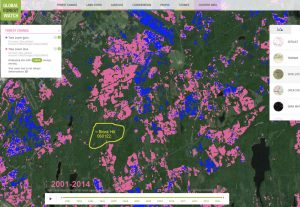
Another bit of unbiased truth northeast of Halifax Airport. View Mimicing Natural Disturbances in Nova Scotia. Click on image for time series.
Crossland also bemoans the lack of transparency. “We know from harvest records that large, mature trees once dominated our landscapes. We’ve tried to obtain age class information from DNR, but it is not readily accessible. There is a lack of government transparency. While volunteering on the forest panel during the Natural Resources Strategy, I was bluntly informed that I didn’t need to know such things; that all the required information was on their website. Halifax Examiner journalist Linda Pannozzo has written extensively about the transparency issue, most recently about the “disappearing forest age class data”.
In the late fall, a member of the Halifax Field Naturalists and I met with a Minister and an MLA in the current NS government to talk about forestry issues. We talked for over an hour. I did appreciate from that discussion the initiatives that the Liberal government has taken to clean up Pictou Harbour, also that the current government has stopped providing direct handouts to the Pulp and Paper mills as practiced by previous NDP, Liberal and Conservative governments. I pointed out that there are still many indirect handouts being made, notably permission to clearcut intensively (large patches) and extensively on Crown lands. However, they did not seem to understand the clearcutting issue and apparently accept the position in a response they elicited from NSDNR: “Clear cutting does not destroy forest habitat”.
Thanks to Donna Crossland for stating the concerns about clearcutting in Nova Scotia in concise, readable form that, bureaucrats, Ministers and MLAs can take time to read and begin to comprehend. It’s time to see some serious, evidence-based discussion of this issue in the legislature. As all three major parties have had a hand in creating and maintaining current practices, such discussions could, in principle, be non-partisan in nature.
—————————–
Restoring the Health of Nova Scotia’s Forests
A panel of expertise report on forests by Bob Bancroft and Donna Crossland to the steering panel for the Nova Scotia Natural Resources Strategy 2010 process. This report was widely applauded, the Steering Panel adopted most of their recommendations, and then NDP Minister of Natural Resources John MacDonell promised fundamental change. He released a set of “strategic directions which included a commitment to “Reduce the proportion of wood harvested by the clear cut method to no more than 50% of all forested lands over a five-year period”. Within months, however, Premier Dexter shifted MacDonell to another Dept. and the Bancroft/Crossland Report was tacitly shelved in favour of an alternative, industrial forestry-oriented Report by Jon Porter. The province was still committed to the 50% target for clearcutting but introduced a definition of clearcutting that effectively allowed a lot of what is functionally a clearcut not to be counted as a clearcut. Four years later the new Liberal government hired Jon Porter as the executive director of the NSDNR’s renewable resources branch. In August of 2016 (the year clearcutting was to have been reduced to 50% of all cuts), the province issued a five-year Progress Report on the 2011-2020 Natural Resources Strategy in which they announced that the 50% target was irrelevant because “We have now developed tools that ensure that all harvest treatments are aligned with the nature-based requirements of Nova Scotia’s lands.” The return to same old same old was complete. Regardless of the history subsequent to the Bancroft/Crossland report, their report still says a lot about the current state of our forests (just add 6 more years of extensive clearcutting and the “biomess”) and where we should be headed. Also see the Research Addendum.
